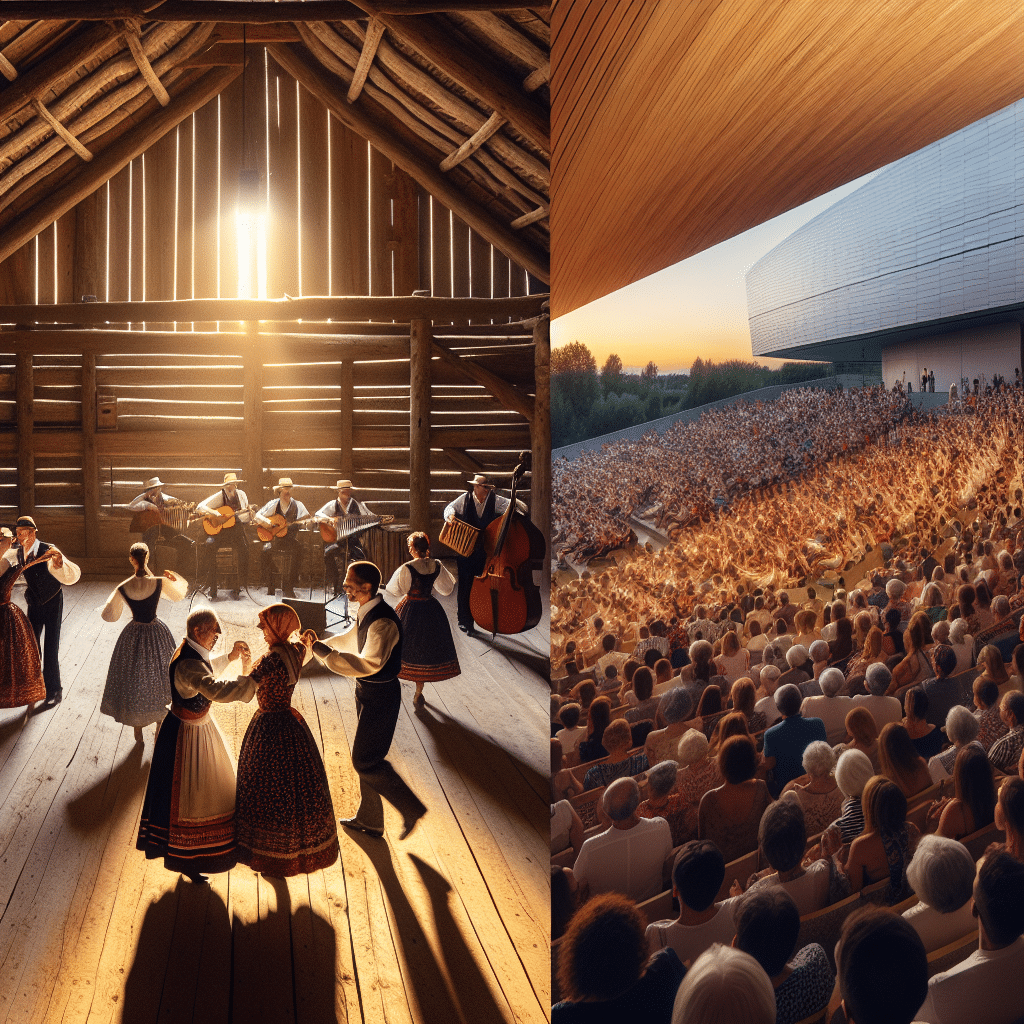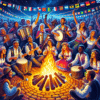“From Barn Dances to Concert Halls: The Evolution of Folk Music”

Folk music has long served as the soundtrack to the collective experiences of communities, bridging generational gaps and reflecting the values, struggles, and joys of the people. Its journey, from rural origins to the grand stages of concert halls, illustrates not only the evolution of the genre, but also the cultural shifts within society. This article explores the transformation of folk music, examining its roots, changes through the ages, and its enduring significance today.
The Roots of Folk Music
Folk music has its origins deeply embedded in the oral traditions that predate recorded history. In the early days, music was predominantly created and disseminated within small communities. It often served practical purposes: songs were employed to accompany labor, celebrate important life events, and tell stories. The melodies and lyrics were passed down orally, adapting and morphing to reflect the collective experiences of each generation.
In these early communities, folk music was characterized by simple instruments—such as fiddles, banjos, and acoustic guitars—and often featured harmonious vocals from community members. Themes of love, hardship, and daily life dominated the lyrics. Different regions developed their own distinct sounds, with Celtic influences in the British Isles, African rhythms in the American South, and indigenous sounds that shaped local traditions.
The Rise of Commercial Folk Music
The first major shift in folk music occurred in the late 19th to early 20th centuries, when the rise of the recording industry began to commercialize what had primarily been a grassroots genre. Prominent folk artists began to gain attention outside their local communities, recording songs and albums that reached broader audiences.
See Also: Folk Revival: A Return to Authenticity in a Digital Age
Folk Revival: A Return to Authenticity in a Digital AgeThe 1930s and 1940s marked the beginning of the folk revival movement in the United States. Artists like Woody Guthrie and Pete Seeger became icons not only for their music but for their social activism. Songs such as "This Land Is Your Land" and "We Shall Overcome" transcended entertainment; they became anthems for social change, advocating for workers' rights and civil rights.
The folk revival brought new life and visibility to traditional songs, and in doing so, it began to fuse various musical styles. The incorporation of blues, jazz, and other genres rejuvenated folk music, allowing it to evolve while still holding on to its roots.
The Folk Music Boom of the 1960s
The 1960s were pivotal for folk music, as it entered a golden era characterized by a surge of popularity among the youth. With the civil rights movement, anti-war protests, and a burgeoning counterculture, folk music became an important vehicle for social commentary and collective action. Artists like Bob Dylan and Joan Baez brought poetry to the forefront, crafting songs that reflected the zeitgeist of a generation.
Dylan’s iconic lyrics and innovative melodies challenged traditional structures while maintaining folk music’s storytelling essence. The Newport Folk Festival, which began in 1959, became a significant platform for both established and emerging artists, solidifying folk music's place in American culture.
See Also: Harmony in Simplicity: Why Acoustic Folk Music is Making a Resurgence
Harmony in Simplicity: Why Acoustic Folk Music is Making a ResurgenceDuring this time, folk music also began to blend with elements of rock and pop, broadening its appeal. The folk-rock movement, exemplified by The Byrds and Simon & Garfunkel, propelled folk music into the mainstream, reaching new audiences in concert halls and on the radio.
The Influence of Technology and Globalization
As the decades progressed, technological advancements continued to shape the landscape of folk music. The advent of the internet and digital platforms allowed musicians to distribute their work globally. Artists no longer needed major record labels to reach audiences; they could share their music directly with fans through social media and streaming services.
Additionally, globalization has had a profound impact on folk music. Musicians increasingly draw on influences from around the world, leading to innovative hybrids that reflect a blend of cultural heritages. The interplay between traditional and contemporary forms has led to a renaissance of folk music, with artists like Mumford & Sons and The Lumineers introducing folk-inspired sounds to new generations.
Contemporary Folk Music: A Diverse Landscape
Today’s folk music is a diverse tapestry that encompasses traditional sounds and modern influences. It exists in various forms, from indie folk to alternative and even folk-inspired rock. Artists like Fleet Foxes and Sufjan Stevens not only honor traditional elements but also challenge the genre’s boundaries, exploring themes of identity, experience, and existence.
See Also: “Melodies of Memory: How Traditional Folk Songs Preserve Cultural Heritage”
“Melodies of Memory: How Traditional Folk Songs Preserve Cultural Heritage”The importance of folk music has endured, as it continues to be a means for storytelling and community. It plays a crucial role in cultural preservation, allowing artists to connect with their heritage while reflecting contemporary issues. Festivals celebrating folk music, such as MerleFest and the Philadelphia Folk Festival, exemplify the ongoing love for the genre and its place in society.
Moreover, folk music serves as a means of healing and solidarity, fostering connections between different cultures and generations. Its egalitarian nature invites participation from all walks of life, reminding us of our shared humanity.
Conclusion: The Importance of Folk Music's Evolution
The evolution of folk music—from barn dances to concert halls—mimics the broader changes in society. It’s a journey that reflects the struggles, aspirations, and voices of the people, continually adapting while staying true to its roots. As we move into the future, the importance of folk music will remain significant, serving as both a reminder of our past and a means for expressing our present and future.
In this ever-changing world, folk music continues to be a powerful tool for storytelling and social connection, uniting individuals through shared experiences and collective memory.
FAQs
See Also: “Voice of the People: Exploring the Stories Behind Traditional Folk Songs”
“Voice of the People: Exploring the Stories Behind Traditional Folk Songs”What distinguishes folk music from other genres?
Folk music is primarily characterized by its roots in oral traditions, often focusing on themes of daily life, community, and storytelling. It typically employs simple melodies and harmonies, using traditional instruments and accessible lyrics.
How has folk music influenced other music genres?
Folk music has significantly influenced genres such as rock, blues, country, and pop. Elements of folk, such as storytelling and acoustic instrumentation, can often be found in modern music, demonstrating its lasting cultural impact.
Are there different styles of folk music around the world?
Yes, folk music varies greatly from region to region, reflecting local histories, cultures, and traditions. For example, Irish folk is known for its lively jigs and ballads while American folk often incorporates blues and African rhythms.
What role do folk festivals play today?
See Also: Gather 'Round the Fire: The Cultural Impact of Folk Music Festivals
Gather 'Round the Fire: The Cultural Impact of Folk Music FestivalsFolk festivals serve to celebrate cultural heritage, bringing together musicians and audiences to share and experience folk music. They provide networking opportunities for artists and foster a sense of community among participants.
How can folk music impact social change?
Folk music has often been a vehicle for social activism, addressing political, social, and environmental issues. Songs can unite people around a common cause, inspire movements, and raise awareness about critical issues.
If you want to know other articles similar to “From Barn Dances to Concert Halls: The Evolution of Folk Music” you can visit the category Folk.
